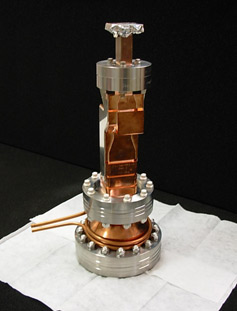
Handy Links
SLAC News Center
SLAC Today
- Subscribe
- Archives: Feb 2006-May 20, 2011
- Archives: May 23, 2011 and later
- Submit Feedback or Story Ideas
- About SLAC Today
SLAC News
Lab News
- Interactions
- Lightsources.org
- ILC NewsLine
- Int'l Science Grid This Week
- Fermilab Today
- Berkeley Lab News
- @brookhaven TODAY
- DOE Pulse
- CERN Courier
- DESY inForm
- US / LHC
SLAC Links
- Emergency
- Safety
- Policy Repository
- Site Entry Form

- Site Maps
- M & O Review
- Computing Status & Calendar
- SLAC Colloquium
- SLACspeak
- SLACspace
- SLAC Logo
- Café Menu
- Flea Market
- Web E-mail
- Marguerite Shuttle
- Discount Commuter Passes
-
Award Reporting Form
- SPIRES
- SciDoc
- Activity Groups
- Library
Stanford
Around the Bay
Fast-tracking Future Superconductors
 In the name of ever-more efficient and powerful accelerators, researchers are always looking for new superconducting materials. Particles speed through accelerator cavities, and
it takes less energy to accelerate them when these cavities are made with
superconducting materials.
In the name of ever-more efficient and powerful accelerators, researchers are always looking for new superconducting materials. Particles speed through accelerator cavities, and
it takes less energy to accelerate them when these cavities are made with
superconducting materials.
A group of researchers from SLAC, Los Alamos National Laboratory, and the Spallation Neutron Source (SNS) at Oak Ridge National Laboratory are developing an innovative technique that will allow physicists to test the properties of possible superconductors with superior efficiency.
"Instead of taking years to study critical fields of superconducting materials, this technique can be used to test new or old superconductors in just weeks," said Isidoro Campisi, a physicist at the SNS. "It's a very powerful selection tool to see whether these materials are promising."
The traditional approach requires a researcher to design and build a specific test cavity for each test material. Now, building on a technique originally developed at SLAC 25 years ago, the team has essentially created a reusable test cavity.
The geometry of the reusable cavity concentrates magnetic fields onto a flat sample of the material, enabling physicists to determine an important quantity called the critical field. If a magnetic field is stronger than this value, the material loses its superconducting properties.
Additionally, the new testing facility has a more efficient and safer cryogenic cooling machine the size of a small refrigerator. "This allows us to do an experiment in a day, whereas before, it would take weeks," said Gordon Bowden, who works on the device at SLAC.
All of these features make the group's reusable cavity unique in how it tests superconducting materials. "I don't think anyone's ever made such a device before," said team member Valery Dolgashev. SLAC is one of only two facilities in the world that can create the strong fields required for this technique.
Once researchers find an improved superconducting material, it will still take time before it is used in an accelerator, said SLAC professor Sami Tantawi. It has taken 30 years to perfect the cavity design for the niobium superconductors that will be used in the ILC.
óMarcus Woo, March 28, 2007
Above image: This cavity tests the properties of possible superconductors.